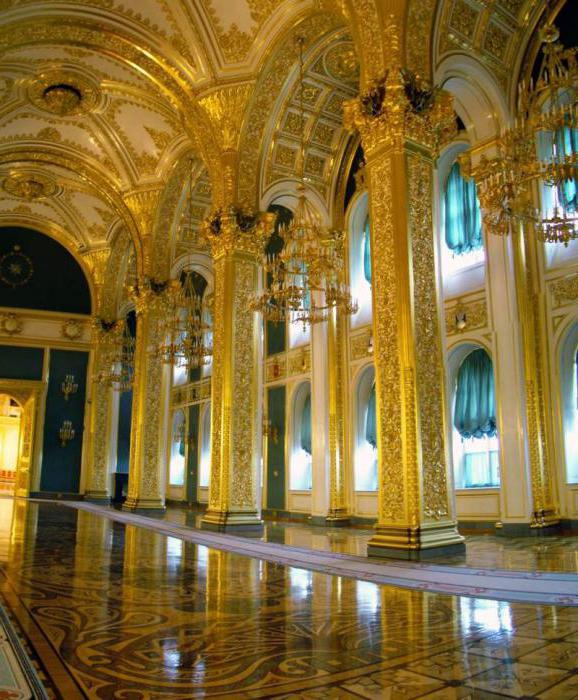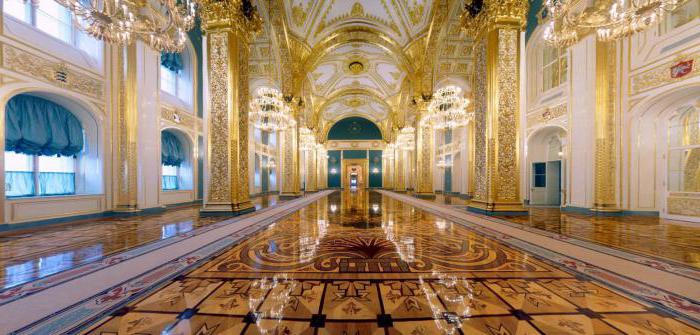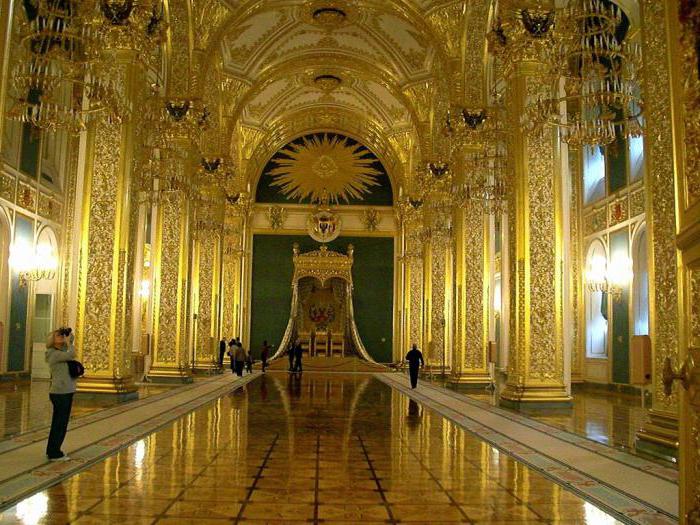St. Andrew's Hall amazes with its luxury and beauty, expensive decoration. And this is not surprising - the kings and queens of Russia sat in it, it has its own history and its own personality.
The photo of the St. Andrew Hall of the Kremlin shows that a lot of work has been invested in its construction.
Briefly about the main thing
The Andreevsky throne room in the Kremlin was built by personal order of Nicholas I in honor of the Order of the Holy Apostle Andrew the First-Called. It became the throne room of the grand palace and the main hall of the Moscow Kremlin. You can not even talk about the magnificent decoration of the room, which makes an impression on every incoming one, caused also by the fact that the walls of the hall are upholstered with moire fabric the color of the St. Andrew's ribbon.
Hall Description
The St. Andrew Hall of the Kremlin is the most famous in the palace. The walls of this room are decorated with pink artificial marble and gilded from above. Gilded chairs upholstered in velvet lined up along them. Coats of arms of Russian provinces are placed above the windows.
Ten gilded pylons adorn the hall, as well as various symbols in the form of crosses, chains. Silk curtains are in perfect harmony with the rest of the decoration of the room. The high gilded doors decorated with order crosses amaze the imagination. Above them are monogram images of the names of the emperors of Russia - Peter the Great, Paul the First and Nicholas the First. Peter as the founder of the order, Paul as the founder of the statute of the order, and Nikolai as the builder of the hall.

At the far end of the hall are three chairs that were intended for the ruler, his wife and mother. This throne can still be seen in the Kremlin, studded with velvet and ermine fur. The emblem of the Russian Empire hangs above the throne , and above it is a radiance with rays covered with gold leaf, in the center of which the All-Seeing Eye has settled. Two-headed eagles with the image on the chest of St. Andrew's cross hang on the sides of the tent. Six steps lead to the tent. Previously, back in Soviet times, a monument to Lenin stood on this site.
The floor, as in other rooms, is made of multi-colored wood and delights all tourists with its beautiful pattern and the huge work that was put into this work of art. It should be noted that the last restoration of the hall was carried out in 1994-1998, when it was restored in its original form. The architect of the St. Andrew's Hall was Konstantin Ton.
History of the St. Andrew Hall of the Kremlin
The main throne room was built in 1838-1849 by the architect Konstantin Ton. This master created the Russian-Byzantine style of temple architecture, which was widely used during the reign of Nicholas the First. From 1932 to 1934 the hall was destroyed. In its place, meetings of the Supreme Council of the USSR were held. In 1997, restoration work began. The leaders of this project were leading architects of the time S.V. Demidova and E.V. Stepanova. Architects carried out tremendous laborious work with archival materials in Russia and abroad. Using past photographs of the hall, using the latest technology, they managed to restore in full, to the smallest detail, the hall, which it was during the reign of Emperor Nicholas the First.

We cannot but mention such a restorer of the highest category as V. A. Ageychenko, who was a sculptor, artist, and engineer all rolled into one. For the throne room, he reproduced the coat of arms of the Russian Empire in bronze. He also created the coats of arms of Russian provinces, which are located above the windows of the St. Andrew Hall. The floors were also recreated by him. Thanks to this man with golden hands , the hall was restored to the smallest detail.
Experts have found that for complete identity, twenty-three types of wood should be used for floor restoration. It was brought from all over the world, even from Africa, but did not change anything, doing everything strictly in accordance with the drawings of the nineteenth century. A total of about ninety-nine firms participated in the restoration work.
The huge room was constantly filled with workers, about 2.5 thousand people worked for days and nights for the benefit of the people. Some ornaments were not obtained immediately, for example, a two-headed eagle. Masters first made an eagle the color of copper. After establishing the commission went to the opposite bank of the river to evaluate the result obtained from afar. They did not like it, because the eagle looked like a black spider. Therefore, they decided to make the eagle the color of "wild stone".
In the St. Andrew's Hall, as in other rooms of the palace, various events are held, including a reception in honor of graduates of military universities. President Yeltsin began this tradition in 1999, and it continues to this day.
St. Andrew Hall of the Kremlin before the revolution and after
In October-November 1917, the Kremlin suffered very seriously due to an armed uprising, and there were detachments of junkers in it. The troops of the revolutionaries carried out shelling of the Kremlin. As a result, the walls of the palace, the Spasskaya tower, the Spassky clock, the Nikolskaya tower, the Beklemishevskaya tower, almost all the churches located on the territory of the Kremlin, and the Small Nikolaevsky palace were damaged.
During the Soviet era, the capital moved to Moscow, and the Kremlin began to be used as a political center. In March 1918, the Soviet government moved with the building of V.I. Lenin. The leaders of the Soviet regime began to live in the palaces and buildings of the Kremlin. Free access to the structure was prohibited. Although before everyone could visit this famous place. The Petrograd Collegium for the Protection of Antiquities and Art Treasures tried to survive the Soviet regime from the Kremlin. The authorities did not even consider their appeal. Before the revolution, three thrones stood in the hall. Later they were searched all over Russia. The first throne was found in Peterhof, the other two - in Gatchina. The Leningrad Museum did not want to give chairs, so I had to make copies.
Destruction during the Soviet era
During the Soviet era, the Moscow Kremlin was badly damaged. By order of Lenin in 1918, a monument to Prince Sergei Alexandrovich was demolished. In the same year, the memorial to Alexander the Second, which was built during the time of Nicholas the First, was also liquidated. In 1922, about 300 pounds of silver, about 2 pounds of gold, and a huge amount of precious stones were withdrawn from church cathedrals and temples. Congresses of councils and congresses of the Third International began to be organized in the Kremlin, cuisine was established in the Golden Chamber, and a public dining room was made in Granovity. The Catherine Church decided to arrange a gym. Such disrespect for an architectural work of art could not but affect its original form. It is believed that at that time the Kremlin lost more than half of its attractions.
In 1990, the Kremlin was inscribed on the UNESCO World Heritage List.
All-seeing eye
Above the thrones is the All-Seeing Eye (in the St. Andrew's Hall of the Kremlin), made of gold. The throne room was erected in honor of the highest order of Russia - the Masonic Order of the Holy Apostle Andrew the First-Called. Some believe that the All-Seeing Eye means God in Christianity (Hebrew translates as "master of the horde," one of the seventy-two secret names of the Jewish Lord God).
This sign is used in many Christian churches, in Freemasonry. One dollar bills also have the All-Seeing Eye. Others believe that this biblical sign is a symbol of the Divine Providence and the emblem of the Trinity. In Christianity, the All-Seeing eye in the triangle means the Trinity and the meaning is in these words: "Behold, the eye of the Lord is on those who fear Him and trust in His mercy."
Excursion to the Kremlin
In Russia, the St. Andrew's Hall of the Kremlin, like other halls, is often visited by tourists. The palace is a specially protected area. You can’t bring anything superfluous to the Kremlin. It is forbidden to come drunk, in an inappropriate appearance, with weapons that are dangerous to others. If there are things that cannot be carried, then they must be taken to a storage room in the Alexander Garden. You can also take pictures not everywhere, but only where it is permitted and where your guide will indicate. For example, it is forbidden to photograph the Catherine’s Hall of the Kremlin.

Sometimes it is forbidden to take pictures in the Grand Canopy, the Terem Palace and the Faceted Chamber. Entrance to the Kremlin is permitted with a passport; children from the age of twelve can come with a passport. True, from the age of fourteen, children can attend excursions with a Russian passport. Since the halls of the Kremlin are used for official events, some other celebrations, it is possible that your tour may be rescheduled to a more suitable time for the palace.
Excursion time
A tour of the St. Andrew's Hall of the Kremlin is held every day, except Thursday - this is a day off. From ten in the morning to three in the afternoon. The duration of the tour is two hours for groups of twenty people. The cost of such an excursion is 4500 rubles, for foreign tourists - 5500 rubles without using the services of an interpreter.
Interesting Facts
During the restoration work, the Italian master was afraid that the workers would make the molding incorrectly, so he slept four days on the floor in the St. Andrew's Hall.
Catherine II also wanted to build a palace on the southern slope of the Kremlin hill, instead of the fortress wall, but her plans were not realized.